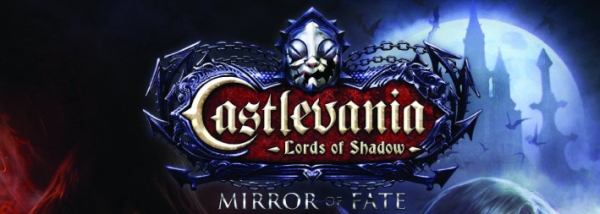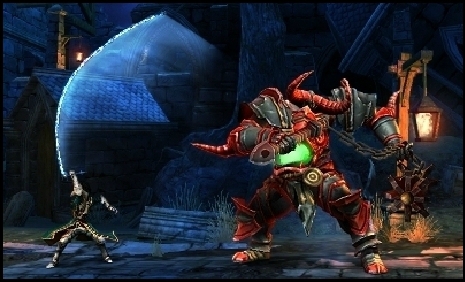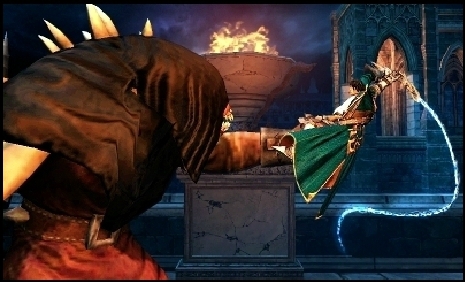
Reboots are all the rage these days. Major titles such as Tomb Raider, Mortal Kombat and Devil May Cry went back to the drawing board and returned with a fresh coat of paint and new stories to tell. Reviews, and for that matter, sales, have also shown us that rebooting a franchise normally yields positive results. One of the earliest reboots this generation, Castlevania: Lords of Shadow wiped the slate clean and gave us an entirely new take on the revered franchise. Lords of Shadow was very well received, and was popular enough to spawn a sequel. Release information for Castlevania: Lords of Shadow 2 has yet to see the light of day (It’s a vampire game, get it?), but until that day comes, we have Castlevania: Lords of Shadow – Mirror of Fate.
Platforms: 3DS
Publisher: Konami
Developer: Mercury Steam
Genre: Metroidvania: Lords of Shadow
Release Date: March 5, 2013
ESRB Rating: Mature
Castlevania: Lords of Shadow – Mirror of Fate’s story takes place through the eyes of three different generations of the Belmont Clan. The separate, yet intertwined, stories jump from Lords of Shadow’s Gabriel Belmont to his grandson, Simon Belmont, then to fan favorite Alucard, and finally to Gabriel’s son, Trevor Belmont. A year before the events of Lords of Shadow, Gabriel’s wife gave birth to his son while he was away on one of his monster-killing missions. The Brotherhood, of which Gabriel is a member, tell Gabriel’s wife about the fate that is to befall the Belmont lineage, and they raise Trevor in secret, hoping one day he would be able to face what his father would soon become. Growing up and having a family of his own, Trevor goes on a quest to destroy the evil monster that killed his mother. Before leaving, he gives his young son Simon a piece of the titular Mirror of Fate for safe keeping, not knowing the power it has over its bearer. The game starts you off playing as Gabriel, which is basically the tutorial. Next, you play as Simon, all grown up and on his own quest of vengeance for the murders of his father and mother by the creatures of the night. Once you complete Simon’s chapter, you play as Alucard, with his own storyline. After that, the game takes you back in time where you play as Trevor. It may sound confusing on paper, but it plays out quite well in the game.
Taking aspects from both the Igarashi versions and the Lord of Shadows versions, Castlevania: Lords of Shadow – Mirror of Fate plays like a melding of the two. If you are going into this expecting a game exactly like the PlayStation classic and the subsequent Game Boy Advance and DS titles, you will be disappointed. Think of Mirror of Fate as “Diet Symphony,” and you’ll be set. The title is not nearly as RPG-centric as the prior 2D titles. You won’t be changing weapons and armor. You won’t be paying attention to stats. You won’t be going on side missions. But where the features seen in the 2D titles are taken out, aspects from Lords of Shadow are placed in – and they work quite well.

The game looks great, too. The backgrounds – especially the outdoor scenes – are gorgeous, and you really get to see the details during the cutscenes. Speaking of which, the major cutscenes are nicely rendered with a cel-shaded look; it’s quite the contrast to the gloomy, realistic approach to the in-game scenes. The 3D is also great, and a perfect fit for this game. Plus, there’s nothing more satisfying than giving a zombie a good uppercut and seeing zombie bits fly towards you. The castle and the characters are detailed and display a lot of personality – I hated those hunchbacks in the original Castlevania, and I hate them in this one too. However, some parts of the castle do look a bit generic (sewers, I’m looking at you), but those are few and far between. The game does slow down when there’s a lot of action on the screen, but again, it doesn’t happen enough to mar the experience. I would also suggest turning the in-game brightness all the way up in order to truly appreciate the visuals.
Music has always been one of the best things about Castlevania. The creepy, gothic organ pieces compliment the creepy, gothic atmosphere perfectly. Mirror of Fate does not disappoint in this regard. You have to hand it to Mercury Steam – they pulled out all the stops with this one. Mirror of Fate features an orchestral score, which is commendable, especially for a handheld title. The sound effects, too, are expertly crafted. I was actually a little saddened when Simon traded in his tried-and-true leather whip for the Combat Cross. Hearing the crisp snap of that whip was so very rewarding. Complimenting the music and sound effects, the voice acting is truly phenomenal. Robert Carlyle returns to the franchise to again voice Gabriel, and you may recognize Richard Madden – Game of Throne’s own Robb Stark – as the voice of Trevor Belmont. Hell, if the game were any more Scottish, it’d include Scrooge McDuck.
As stated earlier, Mirror of Fate plays like Symphony of the Night but with a Lords of Shadow makeover. The game is tried and true Metroidvania – you start off with the bare essentials, and as you progress through the game you earn more abilities that help you reach new areas. For example, when I obtained the grapple ability, I backtracked for fifteen minutes just to get a health upgrade on a previously unreachable ledge – and I loved every minute of it. You earn experience by killing enemies and finding scrolls left behind by dead warriors; then, as you level up, you automatically learn new moves. Your level and skill set transfer over from one character to the other, so if you finish Simon’s chapter at level nine, you start Alucard’s chapter at the same level with the same moves. But don’t think of it as just a skin swap. Each character has their own special abilities and weapons that make them unique, and it’s great to see the return of classic Castlevania weapons such as the axe and the stopwatch (it’s an hourglass, but still has the same effect).
Combat is, for the most part, well-executed. This isn’t your typical hack ‘n’ slash; if you go into the game thinking you can button-mash your way to victory, you will be quickly proven wrong. Dispatching your enemies requires effectively dodging, blocking, and counter-attacking. You also need to be well-versed in your special moves, as some of these monsters are more easily killed when using a particular one. You’ll definitely want to familiarize yourself with the special moves, too: not only are they very powerful but they’re a lot of fun to see in action. Mirror of Fate also features several finishers specific to each enemy. When you beat down enemies to the point where they are flashing, you can press R to finish them off with a move that is as stylish as it is visceral. Just be careful, though – doing these moves can sometimes leave you open to attack. On several occasions I’ve been enjoying my work as I broke the back of an enemy, only to be attacked by the upper half of a zombie just as my finisher ended. This incoming attack was completely unavoidable due to my inability to move or block during the slow recovery time.

Boss battles have always been a major staple of Castlevania games. Especially during the Igarashi games, fighting bosses required a lot of skill, both for the character and the actual player. In this regard, Mirror of Fate delivers. The boss battles are huge, both in size and scope, although it does take a while for them to gain some traction. The first few bosses felt like generic, avoid-the-attack-and-wait-for-the-right-moment fights. Then, once you fight the Succubus, the quality of the battles ramps up significantly. These are without a doubt some of most enjoyable and satisfying boss battles I have ever experienced. I don’t want to give too much away, so all I will say is you must try it out for yourself. The bosses also have checkpoints; if you beat them down to a certain point and die later on during the battle, you restart at that midpoint with more health than when you last entered it. Whether or not this is a good thing is obviously up to the player. It certainly makes the game that much easier, especially for newcomers, but seasoned veterans may see this as a turn-off. I also have the displeasure of reporting that the bane of our existence, the quick-time event, makes a return for the boss battles. Although not as frustrating as they are in games like God of War II, they are more of a nuisance than an asset. Again, it’s a matter of personal preference, and I would prefer it if they never existed.
The game does get glitchy during the final act. A few times I’ve fallen through floors or went through a wall and died; but this did not happen every single time and does not make the game unplayable. Additionally, there isn’t a whole lot to do once you’ve beaten Mirror of Fate. If you 100% the game by collecting all the scrolls, bestiary entries and upgrades, you unlock a bonus cutscene. Additionally, once you finish the game, you unlock hardcore difficulty and your moves, magic and health transfer over to your subsequent playthrough. After that, there’s really not a whole lot more to the game than playing through a second time. That doesn’t necessarily mean it’s not worth the purchase. I completed the game at 100% in about twelve and a half hours, so I personally feel that’s worth the asking price.
Castlevania: Lords of Shadow – Mirror of Fate does an amazing job of taking the best assets of Castlevania games and creating an experience that feels both new and familiar at the same time. Fun gameplay, stunning 3D graphics, and an amazing soundtrack blend together to give us a game that, while different than what we’re used to, is entirely enjoyable. If you’re stuck in your ways and refuse to accept the fact that an easier, slower-paced Castlevania could be fun, Mirror of Fate may not be for you. But if you have an open mind and like playing games that, aside from a few annoyances, are actually entertaining, then go buy this game today.
Have fun storming the castle.

Review Disclosure: A review copy of Castlevania: Lords of Shadow – Mirror of Fate was provided by Konami for the purposes of this review.







